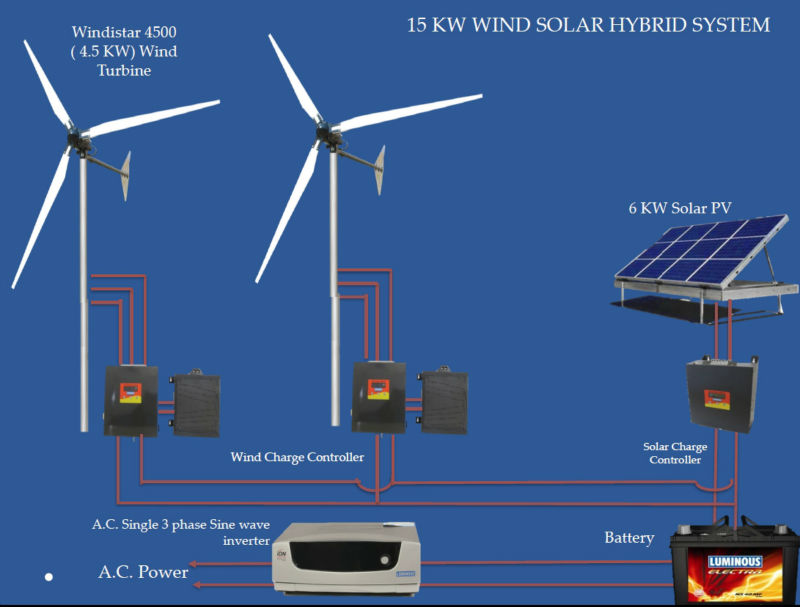
- Home wind turbine vs solar install#
- Home wind turbine vs solar generator#
- Home wind turbine vs solar free#
However, that’s only the case in areas where the wind is abundant and constant. Looking at those basic measurements, wind energy appears to be more than twice as efficient as solar energy. Not bad, but wind turbines turn roughly 50% of captured wind into energy. The most efficient solar panels can capture and convert about 23% of sunlight into energy. Wind Energy: More Efficient, Less AbundantĪt this time, wind turbines are considered more efficient than solar panels. Let’s take a look at some of the factors that influence the efficiency of wind and solar energy. In some locations, solar energy is going to be much easier to produce, but in other places wind energy is more readily available. Because these are naturally derived energy sources, the most efficient option largely depends on the environment where you live. You may be wondering which one is more efficient: solar energy or wind energy. Right now, solar energy and wind energy are the most widely utilized types of renewable power. We’ve gone from relying on fossil fuels to having a selection of viable renewable energy sources in a very short period of time, and the industry is still innovating. The question now is which green energy source is the most efficient. You should make sure that your property is properly insulated before installing renewable technologies.As we move toward greener and cleaner energy sources, the question isn’t whether renewable resources will be adopted. For battery storage systems, typical battery life is around six to ten years, depending on the type, so batteries may have to be replaced at some point in the system's life. Wind turbines can have a life of up to 22.5 years, but require service checks every few years to make sure they work efficiently. But it's important to remember that costs always vary depending on location and the size and type of system. In certain circumstances, noise from the turbine blades could potentially cause problems with adjoining neighbours.Ĭosts would include the turbine, mast, inverters, battery storage (if needed) and installation. there are no major obstacles nearby such as buildings, trees or hills that are likely to reduce the wind speed or increase turbulence.the local annual average wind speed is five metres per second (m/s) or more - you can check this using the link below.The Energy Saving Trust says you should only consider a wind turbine when: This is because the electricity generated is highly dependent on the speed and direction of the wind.
Home wind turbine vs solar install#
Ideally, you should carry out a professional assessment of the local wind speed for a full year at the exact location where you plan to install a turbine before proceeding.


It is important to find out the structural stability of the wall or roof-top where the turbine is to be anchored. Small scale building integrated turbines are now available to install in homes and other buildings. These can be mounted on gable walls, roof-tops or poles and are rated at 1KW to 6KW depending on the model.
Home wind turbine vs solar free#
The ideal site is a hill with a flat, clear exposure, free from strong turbulence and obstructions like large trees, houses or other buildings. It's best to have the turbine high on a mast or tower, as wind speed increases with height. A mixed wind and diesel system gives greater efficiency and flexibility than a diesel-only system.
Home wind turbine vs solar generator#
It's common to run this system with a diesel generator for use during periods of low wind speeds. Any unused or excess electricity can be exported to the grid and sold to the local electricity supply company. A special inverter and controller converts DC electricity to AC. Wind systems can be installed where there is already a connection to the national grid. You also need a controller to divert power to another useful source (such as space and/or water heaters) when the battery is fully charged. The DC electricity needs to be converted to AC (alternating current) for mains electricity. Most small wind turbines generate direct current (DC) electricity and store it in a battery.

A typical domestic system for a home would be 2.5 to six kilowatts (kW), depending on the location and size of the house. Individual wind turbines vary in size and power output from a few hundred watts to two or three megawatts (one megawatt equals 1,000 kilowatts). Small-scale wind power is particularly suitable for remote locations where conventional methods of electricity supply are expensive or impractical. Find out whether wind power is right for you, or whether you should be considering another technology, like solar power or micro combined heat and power. Choosing the right technologyĭifferent green energy technologies are more suited to some types of homes than others.

Northern Ireland has one of the best wind resources in Europe. Modern wind turbines use the wind to turn aerodynamically shaped blades on a rotor which creates electricity.


 0 kommentar(er)
0 kommentar(er)
